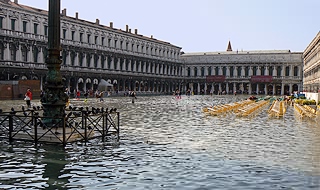 W
WAcqua alta is the term used in Veneto for the exceptional tide peaks that occur periodically in the northern Adriatic Sea. The peaks reach their maximum in the Venetian Lagoon, where they cause partial flooding of Venice and Chioggia; flooding also occurs elsewhere around the northern Adriatic, for instance at Grado and Trieste, but much less often and to a lesser degree.
 W
WBurano is an island in the Venetian Lagoon, northern Italy, near Torcello at the northern end of the lagoon, known for its lace work and brightly coloured homes. The primary economy is tourism.
 W
WDorsoduro is one of the six sestieri of Venice, in northern Italy.
 W
WThe Fondaco dei Tedeschi is a historic building in Venice, northern Italy, situated on the Grand Canal near the Rialto Bridge. It was the headquarters and restricted living quarters of the city's German (Tedeschi) merchants.
 W
WThe Fondaco dei Turchi is a Veneto-Gothic style palazzo, later on named as the Turks' Inn, on the Grand Canal of Venice, northeast Italy.
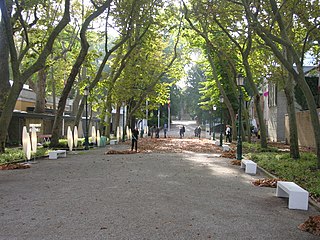 W
WThe Venice Giardini or Giardini della Biennale is an area of parkland in the historic city of Venice which hosts the Venice Biennale Art Festival, a major part of the city's cultural Biennale. The gardens were created by Napoleon Bonaparte who drained an area of marshland in order to create a public garden on the banks of the Bacino di San Marco which is a narrow stretch of water dividing the gardens from St. Mark's Square and the Doge's Palace.
 W
WGiudecca is an island in the Venetian Lagoon, in northern Italy. It is part of the sestiere of Dorsoduro and is a locality of the comune of Venice.
 W
WThe Giudecca Canal is a body of water that flows into the San Marco basin in Venice, Italy.
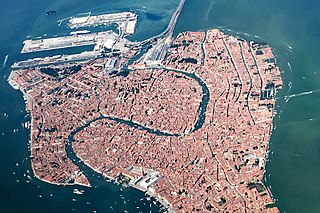 W
WThe Grand Canal is a channel in Venice, Italy. It forms one of the major water-traffic corridors in the city.
 W
WThe Grand Canal is the main central water course in the city of Venice, Italy.
 W
WThe Gulf of Venice is a gulf that borders modern-day Italy, Slovenia and Croatia, and is at the north of the Adriatic Sea between the delta of the Po river in Northern Italy and the Istria peninsula in Croatia.
 W
WSan Michele is an island in the Venetian Lagoon, northern Italy. It is associated with the sestiere of Cannaregio, from which it lies a short distance northeast.
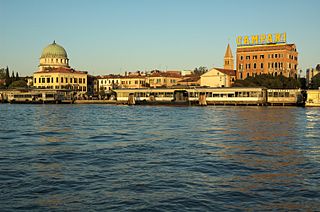 W
WThe Lido, or Venice Lido, is an 11-kilometre-long (7-mile) barrier island in the Venetian Lagoon, northern Italy; it is home to about 20,400 residents. The Venice Film Festival takes place at the Lido late August/early September.
 W
WMalamocco was the first, and for a long time, the only settlement on the Lido of Venice barrier island of the Lagoon of Venice. It is located just south of the island's center and it is part of the Lido-Pellestrina borough of the municipality of Venice.
 W
WMarghera is a municipalità (borough) of the comune of Venice, Italy. It includes the industrial area known as Porto Marghera or Venezia Porto Marghera.
 W
WMazzorbo is one of various islands in the northern part of the Lagoon of Venice. Like the other islands in this part of the lagoon, it was the site one of the earliest settlements in the lagoon which predated the development of Venice. However, these islands then declined and were eventually abandoned. In the 1980s the architect Giancarlo De Carlo built a brightly coloured residential neighbourhood to help to repopulate Mazzorbo. In 2019 its population was 256. It is linked to Burano by a wooden bridge. It was once an important trading centre but is now known for its vineyards and orchards. Its main attraction is the fourteenth century church of Santa Caterina.
 W
WMestre is the most populated borough of the comune of Venice, in Veneto, Italy.
 W
WMOSE is a project intended to protect the city of Venice, Italy, and the Venetian Lagoon from flooding.
 W
WMurano is a series of islands linked by bridges in the Venetian Lagoon, northern Italy. It lies about 1.5 kilometres north of Venice and measures about 1.5 km (0.9 mi) across with a population of just over 5,000. It is famous for its glass making. It was once an independent comune, but is now a frazione of the comune of Venice.
 W
WPunta della Dogana is an art museum in one of Venice's old customs buildings, the Dogana da Mar. It also refers to the triangular area of Venice where the Grand Canal meets the Giudecca Canal, and its collection of buildings: Santa Maria della Salute,, the Patriarchal Seminary of Venice, and Dogana da Mar at the triangle's tip.
 W
WThe Rialto is a central area of Venice, Italy, in the sestiere of San Polo. It is, and has been for many centuries, the financial and commercial heart of the city. Rialto is known for its prominent markets as well as for the monumental Rialto Bridge across the Grand Canal.
 W
WThe Riva degli Schiavoni is a waterfront area in Venice, Italy. There is a lively – albeit often overcrowded – promenade along the waterfront, which sits on St. Mark's Basin.
 W
WSacca Fisola is an artificial island in the Venetian Lagoon. It is a largely modern residential area.
 W
WSan Francesco del Deserto is an island in the Venetian Lagoon in Véneto, Italy, with a surface of some 4 ha. It is located between Sant'Erasmo and Burano. It houses a minorites convent.
 W
WSan Giorgio Maggiore is one of the islands of Venice, northern Italy, lying east of the Giudecca and south of the main island group. The island, or more specifically its Palladian church, is an important landmark. It has been much painted, featuring for example in a series by Monet.
 W
WSan Marco basin in Venice, Italy, is an area of the Venetian Lagoon that faces the Riva degli Schiavoni and Doge's Palace of the San Marco sestiere.
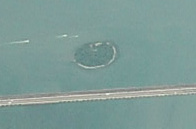 W
WSan Secondo is a small deserted island located in the Venetian Lagoon, northern Italy.
 W
WSant'Elena is an island of Venice. It lies at the eastern tip of the main island group and forms part of sestiere of Castello. The original island was separated by an arm of the Venetian Lagoon from Venice itself, and was centred on the Church of Sant'Elena and its monastery, originally built in the twelfth century and rebuilt in the 15th.
 W
WTorcello is a sparsely populated island at the northern end of the Venetian Lagoon, in north-eastern Italy. It was first settled in the year 452 and has been referred to as the parent island from which Venice was populated. It was a town with a cathedral and bishops before St Mark's Basilica was built.
 W
WThe Venetian Ghetto was the area of Venice in which Jews were compelled to live by the government of the Venetian Republic. The English word ghetto is derived from the Jewish ghetto in Venice. The Venetian Ghetto was instituted on 29 March 1516. It was not the first time that Jews in Venice were compelled to live in a segregated area of the city. In 1552 Venice had 160,000 inhabitants, including 900 Jews, who were mainly merchants.
 W
WThe Venetian Lagoon is an enclosed bay of the Adriatic Sea, in northern Italy, in which the city of Venice is situated. Its name in the Italian and Venetian languages, Laguna Veneta—cognate of Latin lacus, "lake"—has provided the English name for an enclosed, shallow embayment of salt water, a lagoon.
 W
WVetrego is a frazione of the comune of Mirano, Italy, Province of Venice, Region Veneto.